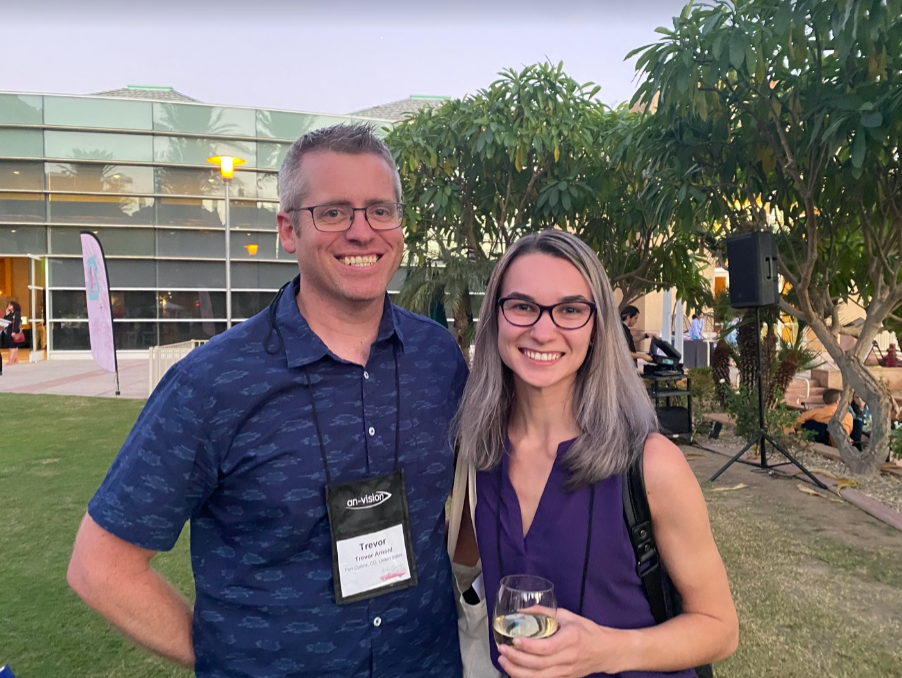Wednesday
Mar082023
Student Experiences: AVCO 2022
 Wednesday, March 8, 2023 at 12:00PM
Wednesday, March 8, 2023 at 12:00PM Submitted by Marissa Matthews, Ross University
My name is Marissa Matthews and I’m a clinical year veterinary student about to graduate with the Pink Semester Class of 2023. Veterinary ophthalmology has been an interest on mine since before starting at Ross University School of Veterinary Medicine (RUSVM). I had been eyeing the annual American College of Veterinary Ophthalmologists (ACVO) Conference each year, hoping the dates would fall during a semester break. Unfortunately, this was not the case, but I knew clinical year would be an opportune time to attend the conference in person. With the help of SAVMA’s Professional Development Funds (PDF), I was able to travel to Palm Springs, CA and attend my first ACVO conference.
The General Session included three days of in-depth lectures, research presentations, and networking opportunities. Many of these topics were a little over my head, such as vitreoretinal surgery and endolaser treatment; however, other topics were immensely helpful, like managing feline herpesvirus. Overall, this was a very informative experience, and it allowed me to reconnect with ophthalmologists I’d met over the years. Though the highlight for me was on the last day of the conference.
The General Practitioners’ Practical Ophthalmology Course was an all-day lecture series geared toward primary veterinary care providers. This was the perfect way to end the conference, as it contained valuable diagnostic and therapeutic advice about common ocular conditions. I think any veterinary student would benefit from this course, which can be taken separately from the General Session. While I can’t delve into every lecture, the presentation I would like to highlight contains information that I believe would benefit the RUSVM student body the most.
Dr. Lucien Vallone’s “Smartphone Ophthalmology” presentation demonstrates how to make ophthalmology more accessible by obtaining high quality photos with minimal equipment. These photos can be used to identify small lesions, document response to therapy, and discuss referral options. The techniques described were for non-magnified imaging, magnified imaging, direct fundoscopy, and indirect fundoscopy.
Non-magnified imaging uses a smartphone camera with room lights on, which is ideal for head photos, eyelids, or for demonstrating asymmetry with two views: a front and dorsal (top down) view. When obtained prior to application of proparacaine, the photos can be evaluated for blepharospasm (squinting) and help differentiate between buphthalmos (enlarged eye) and exophthalmos (pushed forward eye of normal size).
Magnified imaging utilizes a $15 EasyMacro lens over a smartphone. The “recipe” is phone + EasyMacro lens + white tape filter over LED flash + room lights off + video mode with continuous flash + anchored hand-phone-patient position. The video can be used to obtain as many screenshots as necessary to document all pathologies, then crop the final images, and the large video file can be deleted. Common mistakes for this method are leaving the room lights on or having the EasyMacro band overlap the flash on the phone. It is important to note that the EasyMacro band is a typical rubber band that can dry out, so it should be kept in its clear plastic pouch when not in use.
Direct fundoscopy utilizes the same “recipe” as above, just without the macro lens. Limitations of this technique are that any lens opacity will impede viewing the fundus, peripheral lesions are difficult to visualize due to the narrow field of view, and shadowing occurs when there is a large distance between the LED flash and camera lens. Indirect fundoscopy overcomes all those limitations by using the direct fundoscopy “recipe” with a condensing lens (20D to 40D). Volk has a Single-Use 20D lens that can be bought in bulk, $170 for a box of 10. I would like to disclose that neither myself nor the presenter have a financial incentive in promoting either of the above-mentioned products.
I’m grateful for the opportunity to attend the ACVO conference and subsequently share some of the knowledge I was imparted with. I would encourage anyone to attend the General Practitioners Course, especially those looking for an ophthalmology refresher. I would also recommend that students utilize programs like SAVMA PDF, to attend an event or conference in their field of interest.

| Comments Off
tagged  conferences,
conferences,  ophthalmology,
ophthalmology,  student experience in
student experience in  Experiences
Experiences
 conferences,
conferences,  ophthalmology,
ophthalmology,  student experience in
student experience in  Experiences
Experiences 